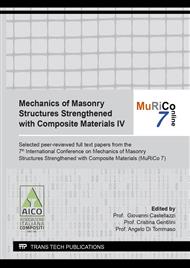p.319
p.328
p.335
p.344
p.352
p.361
p.369
p.377
p.385
Efficiency of Strengthening Interventions on Stone Masonry Panels through Grout Injection and FRCM
Abstract:
Fiber Reinforced Cementitious Matrices (FRCM) represent a very efficient strengthening solution for the retrofitting of masonry structures. When dealing with stone masonry walls, the use of these composite materials is usually combined with grout injection, which can be crucial to ensure a monolithic behavior of the structural element. The objective of this research was the study of the shear behavior of stone masonry samples subject to grout injection and strengthened by two different FRCM systems. Nevertheless, on few samples, grout injection only was performed. Before the execution of the diagonal compression tests, sonic tests were conducted with the objective of evaluating the quality of the grout injection. The Digital Image Correlation technique was also adopted to accurately measure the thickness of the FRCM layers, which can be variable according to the irregular surface of the stone masonry. The results of the experimental campaign showed that the correct execution of the grout injection is crucial for the strengthening solution to be effective since the efficiency of the FRCM system can be reduced if a monolithic behavior of the stone masonry panels is not ensured. The application of the FRCM strengthening system could influence the failure mode, further enhancing the capacity of the samples. Comparisons between the experimental results are presented in the paper.
Info:
Periodical:
Pages:
352-360
Citation:
Online since:
April 2022
Authors:
Price:
Сopyright:
© 2022 Trans Tech Publications Ltd. All Rights Reserved
Share:
Citation:


